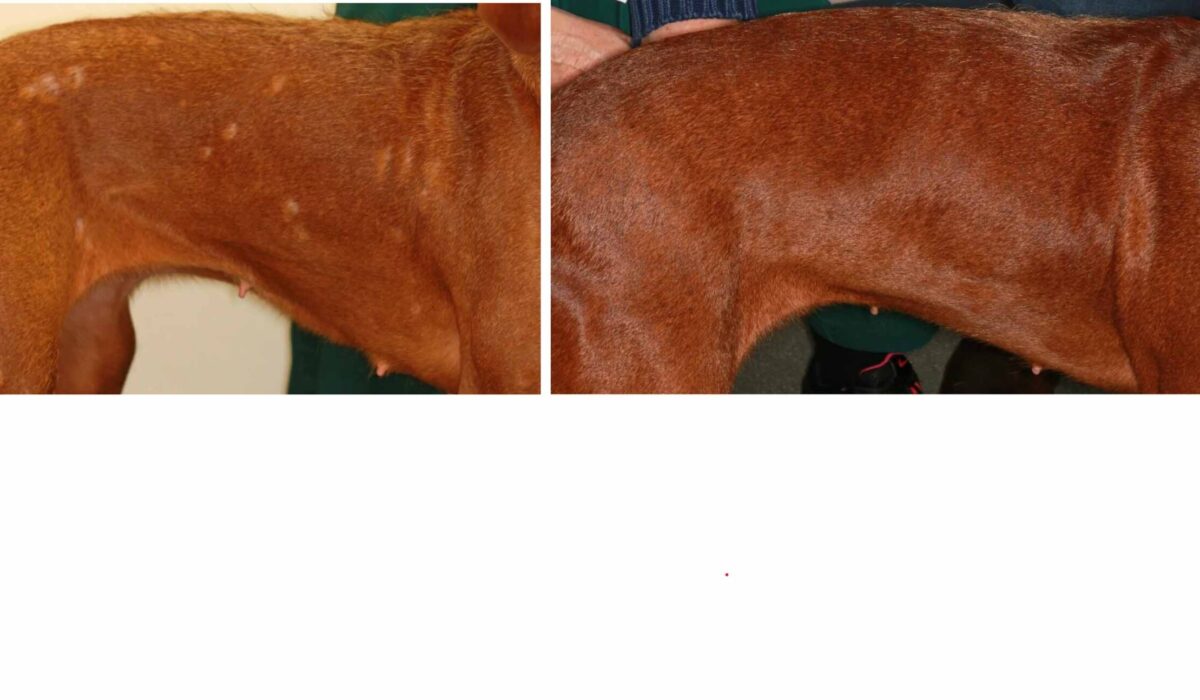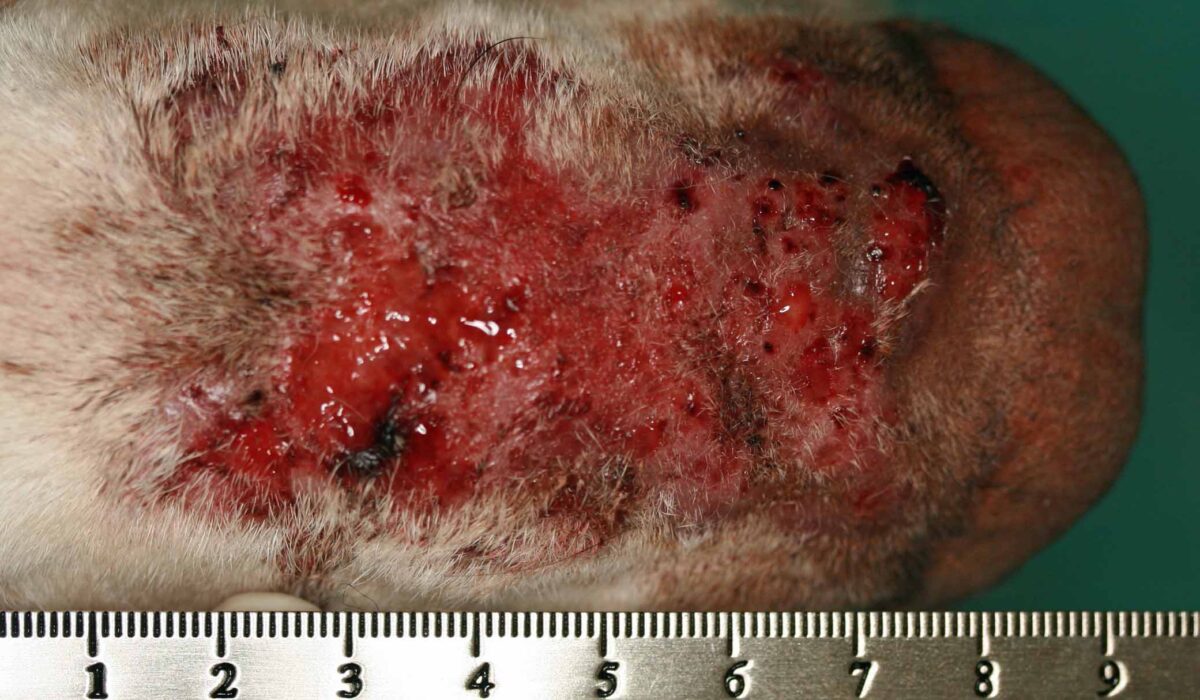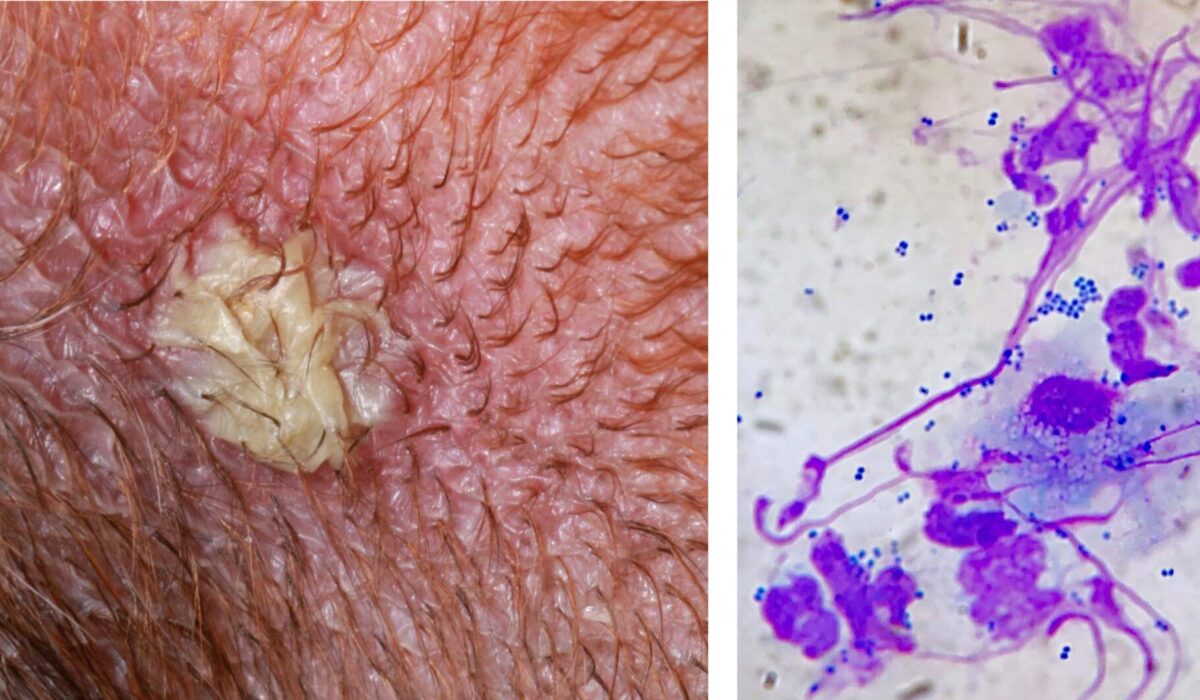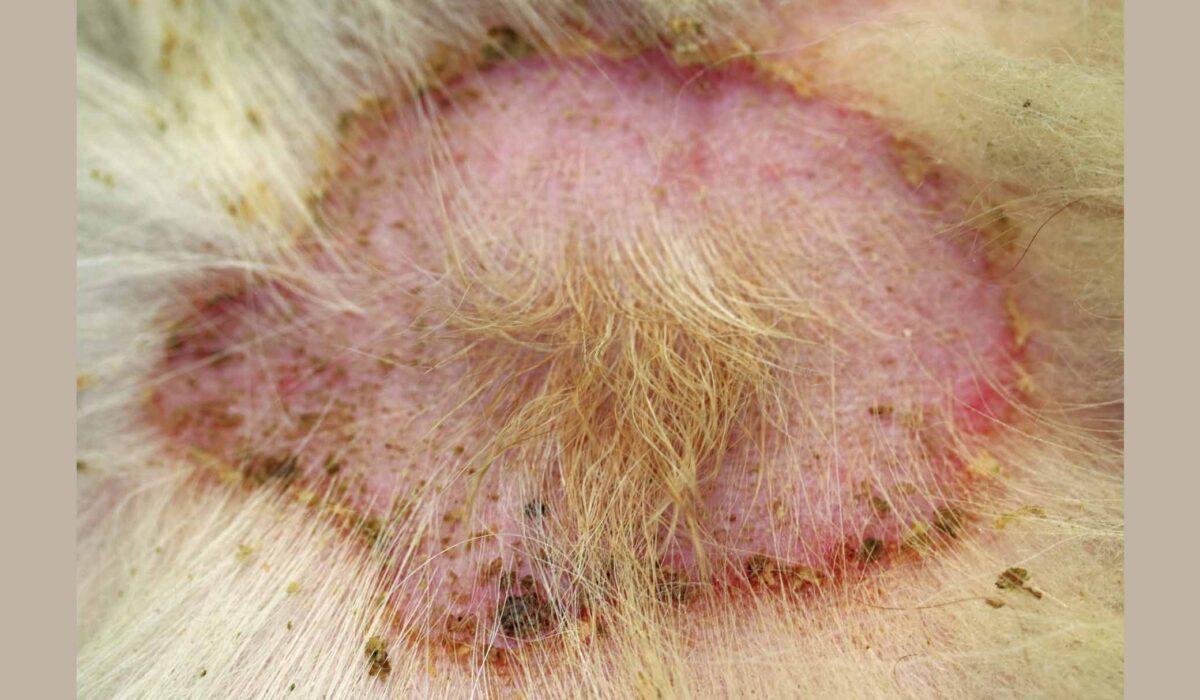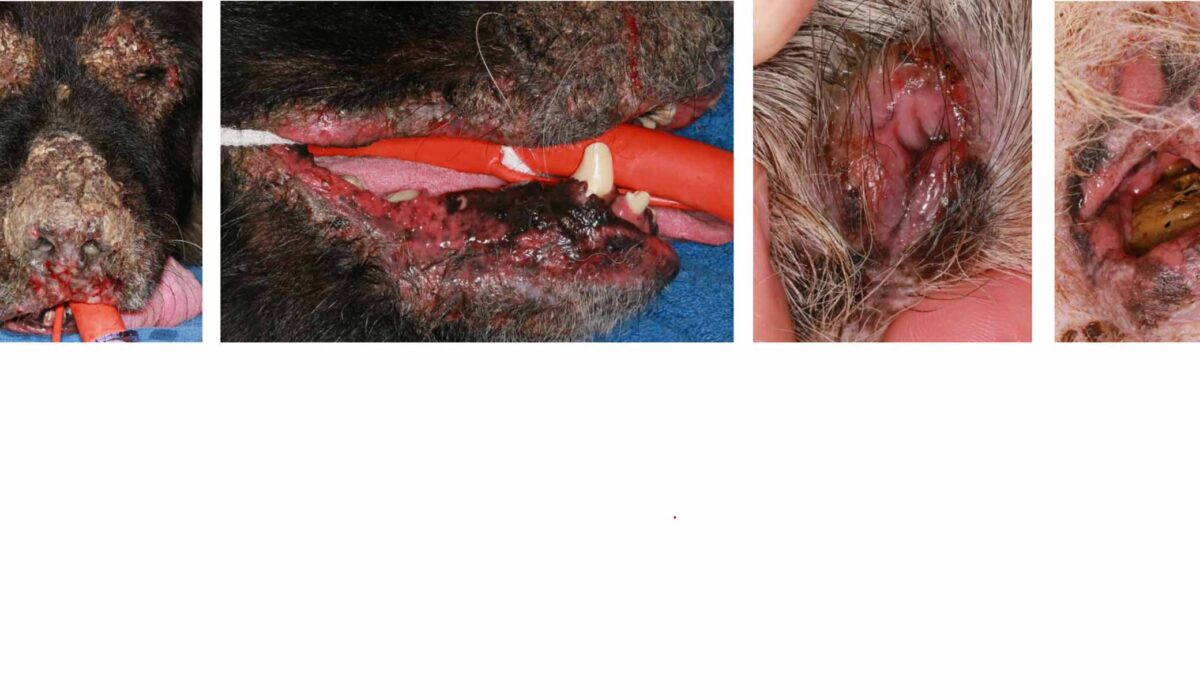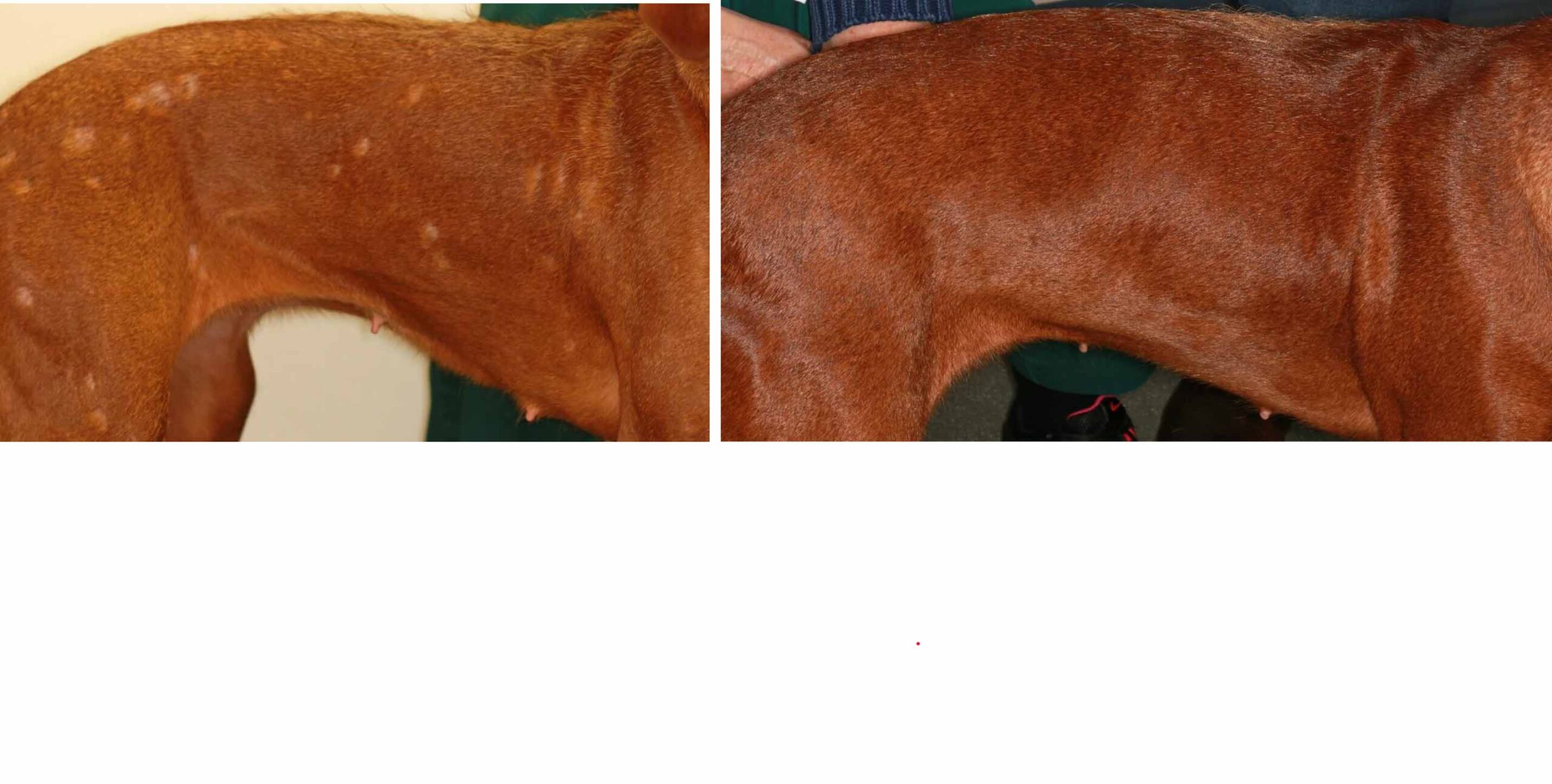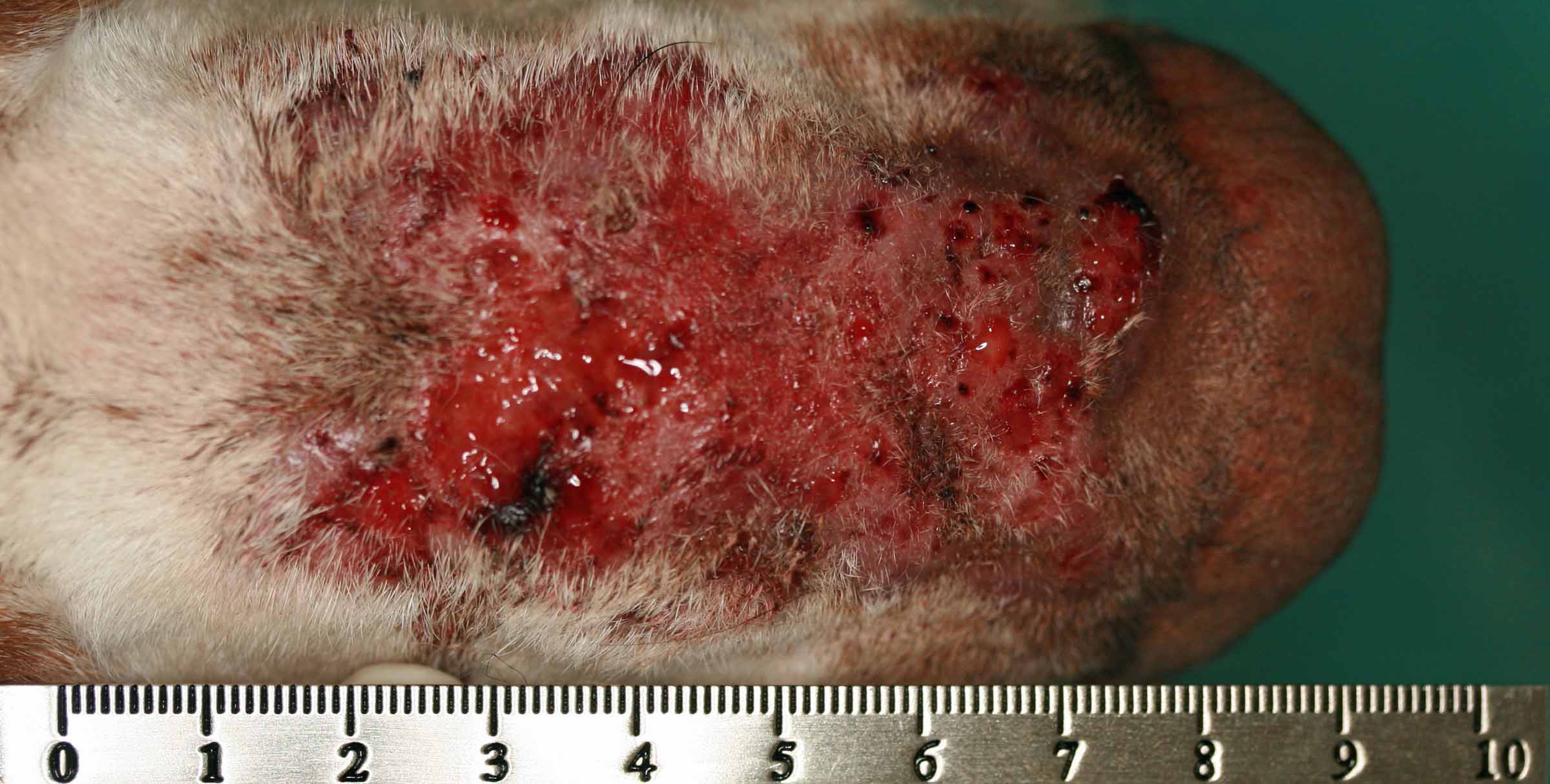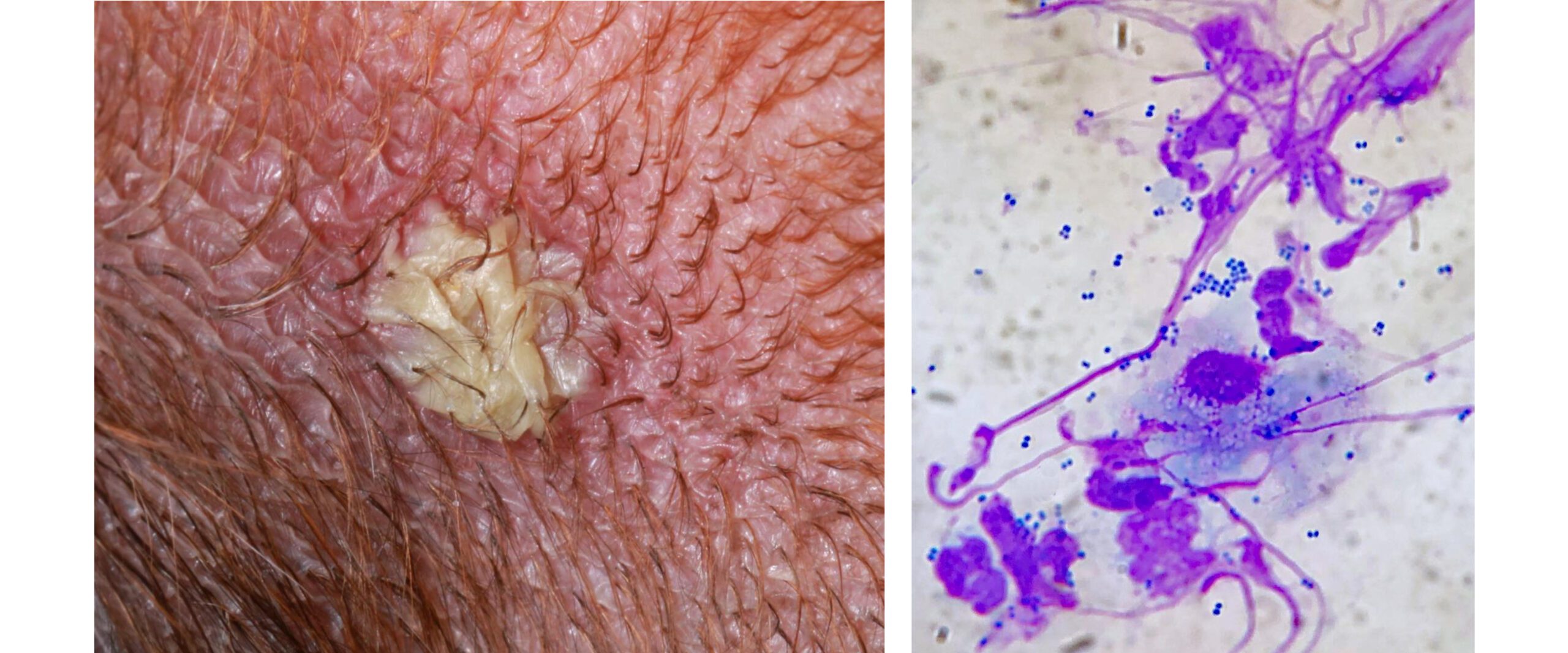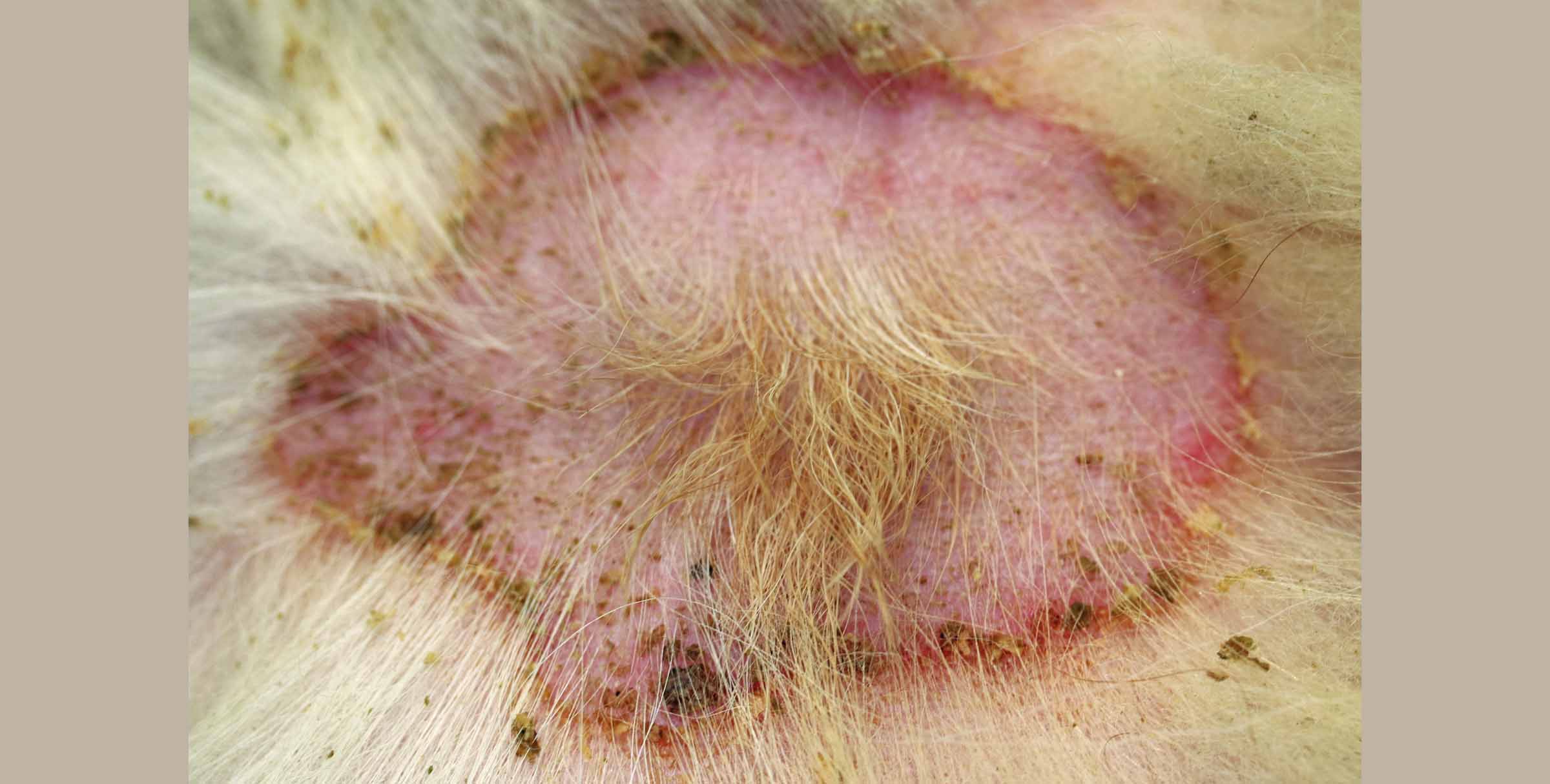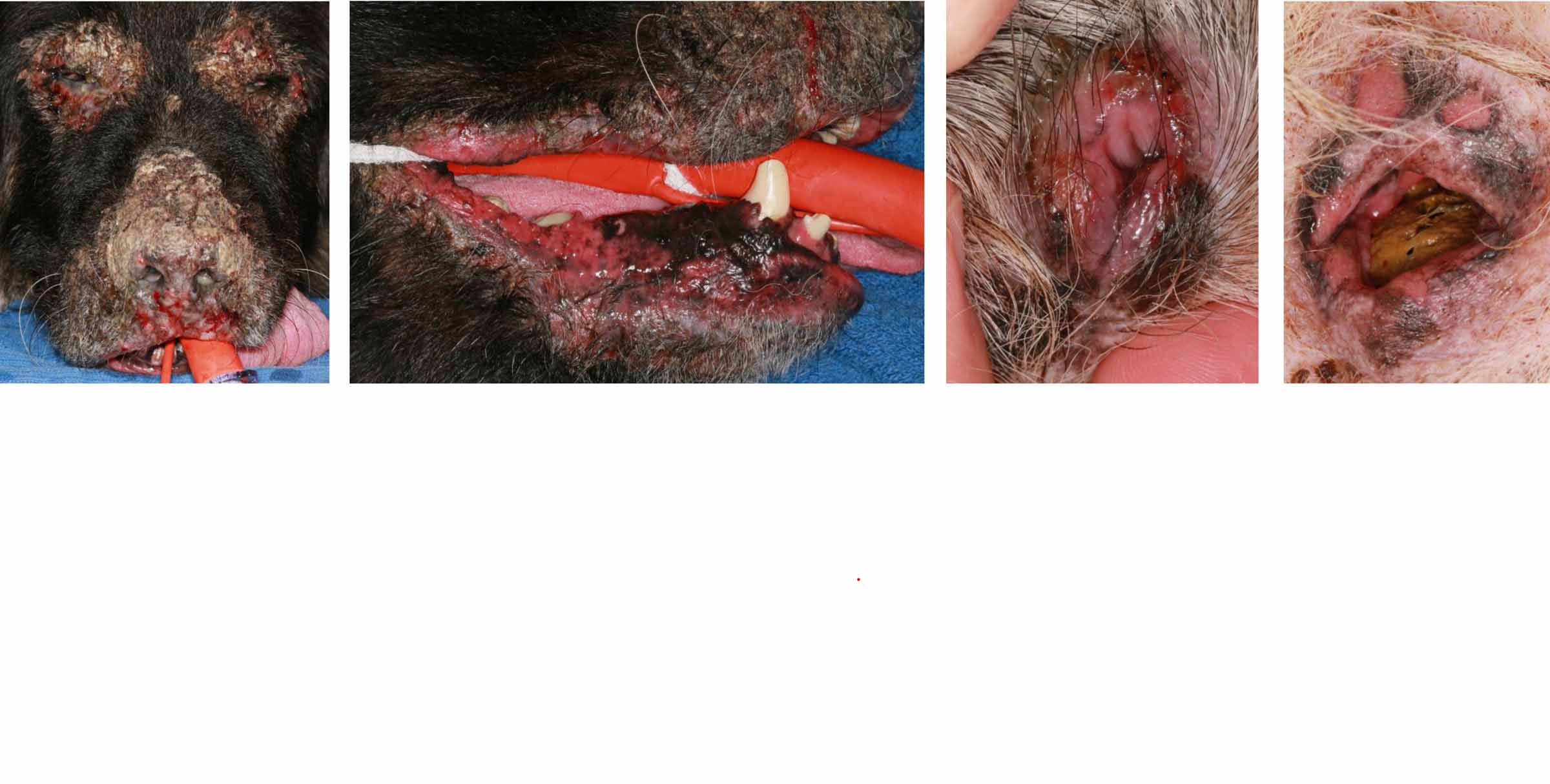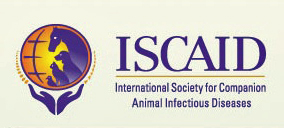throughout 2024, I prescribed FIVE systemic antibacterial courses to my canine Referral cases despite seeing bacterial infections & dysbiosis on a daily basis (1 dog awaiting4 skin biopsy, only 1 with bacterial pyoderma, 1 with deep proderma, 1 with severe autoimmune disease whilst awaiting biopsy results & finally 1 receiving chemotherapy for generalsied skin cancer).
Download my advice regarding antimicrobial use here: 2023 TheSkinVet Recommendations for Antimicrobial Use in Canine Dermatitis and Otitis (in the UK).
In 2023 RCVS Knowledge Awards for Antimicrobial Stewardship ( https://knowledge.rcvs.org.uk/amr/ ) – the awards panel were ‘particularly impressed with (my) commitment to antimicrobial stewardship and (my) ‘excellent clinical service’.
Superficial bacterial folliculitis (SBF), or superficial pyoderma, is a very common presenting sign in canine dermatitis. It is usually caused by Staphylococcus pseudintermedius and is almost always a secondary infection. It should be routinely treated with a combination of both topical and systemic antimicrobial agents. Infection is a consequence of reduced immunity associated with alterations of the skin barrier and underlying diseases that can be difficult to diagnose and control. If the primary disease is not diagnosed and addressed SBF will recur and repeated cycles of treatment will be necessary.
Unfortunately many dogs, with bacterial pyoderma, receive sub-optimal doses of oral antibacterials and in addition the duration of the course are often too short. A minimum length of course is considered to be three weeks long or at least seven days past visible cure. All to often oral treatment is not accompanied by topical medication. The concurrent use of medicated shampoos improves the speed of resolution of infection and can then be used weekly to fortnightly, in the longer term, to reduce the predictable recurrence of infections. Nowadays combinations of topical modalities such a whole body & head shampoos, mousses, spray and gels, have become available, which can be tailored to the patient’s particular condition and behaviour as well as the client’s lifestyle, to aid compliance thereby improving treatment success rates.
The multiple benefits of topical antiseptic therapy include: physical removal of scale, crust, debris and irritants; physical removal of allergens; moisturising, restoring, repairing and strengthening the dysfunctional barrier function; controls active infections; reducing colonization by pathogens and normalizing the skin microbiome (the community of microorganisms that live on the skin); providing additional relief from itchiness; decreasing malodour; low risk of skin or systemic toxicity; reducing reliance on systemic antibacterials as a sole therapy; reducing selection of resistant bacterial strains; shortening time to regain control of infections and maintaining control thereafter to prevent relapses which in turn reduces costs. It is important to emphasize that this refers to topical antiseptics not topical antibacterials.
Poor therapeutic measures against SBF have eventually encouraged the emergence of multi-resistant bacteria, particularly meticillin-resistant S. pseudintermedius (MRSP). This serious problem has focused attention on the need for optimal management of SBF.
Multiple drug resistance (MDR) in staphylococci, including resistance to the semi-synthetic penicillinase-resistant penicillins such as meticillin, is a problem of global proportions that presents serious challenges to the successful treatment of staphylococcal infections of companion animals as well as humans.
I have pledged to become an antibiotic guardian with Public Health England’s AB stewardship directive (https://antibioticguardian.com/) and am actively compiling data of antibacterial use by veterinary general practitioners, in companion animal dermatology cases, to highlight the correct use of these invaluable weapons against infection.
![]() Clinical Consensus Guidelines of World Association for Veterinary Dermatology
Clinical Consensus Guidelines of World Association for Veterinary Dermatology
Recommendations for approaches to meticillin-resistant Staphylococcal infections of small animals – diagnosis, therapeutic considerations and preventative measures. Adherence to these guidelines for the diagnosis, laboratory reporting, judicious therapy (including restriction of use policies for certain antimicrobial drugs), personal hygiene, and environmental cleaning and disinfection may help to mitigate the progressive development and dissemination of MDR staphylococci.
Veterinary Dermatology Journal, June 2017, Volume 28, Issue 3, Pages: 304-e69, Daniel O. Morris, Anette Loeffler, Meghan F. Davis, Luca Guardabassi and J. Scott Weese
This article is free for all to access and kindly made available through the Wiley Online Library: Click Here To Access
![]() Guidelines for the diagnosis and antimicrobial therapy of canine superficial bacterial folliculitis
Guidelines for the diagnosis and antimicrobial therapy of canine superficial bacterial folliculitis
Antimicrobial Guidelines Working Group of the International Society for Companion Animal Infectious Diseases
Veterinary Dermatology Journal, June 2014, Volume 25, Issue 3, Pages: 163–e43, Andrew Hillier, David H. Lloyd, J. Scott Weese, Joseph M. Blondeau, Dawn Boothe, Edward Breitschwerdt, Luca Guardabassi, Mark G. Papich, Shelley Rankin, John D. Turnidge and Jane E. Sykes
This article is free for all to access and kindly made available through the Wiley Online Library.
![]() Another useful source of information is The British Small Animal Veterinary Association website http://www.bsava.com/ : search for their Guidelines on Responsible Antibacterial Use.
Another useful source of information is The British Small Animal Veterinary Association website http://www.bsava.com/ : search for their Guidelines on Responsible Antibacterial Use.
There are also a number of useful extra resources, including their Protect poster: 20240101 BSAVA SAMsoc Protect Me Poster
(Practice policy, Reduce prophylaxis, Other options, Types of bacteria and drugs, Employ narrow spectrum, Culture and sensitivity, Treat effectively – Monitor, Educate others)
There is also advice on Meticillin-resistant staphylococci in companion animals and includes the BSAVA Practice Guidelines for reducing these risks. as well as managing infected patients by Dr Tim Nuttall, Bsc BVSc CertVD PhD Cbiol MSB MRCVS, RCVS Specialist in Veterinary Dermatology, a senior lecturer in Veterinary Dermatology at the University of Edinburgh: https://www.bsava.com/Resources/MRSA.aspx
![]() These two articles below are also free for all to access and kindly made available through the Vet Record website (the journal of the British Veterinary Association) – Click Here To Access
These two articles below are also free for all to access and kindly made available through the Vet Record website (the journal of the British Veterinary Association) – Click Here To Access
Suggested guidelines for using systemic antimicrobials in bacterial skin infections:
part 1—diagnosis based on clinical presentation, cytology and culture
part 2— antimicrobial choice, treatment regimens and compliance
, Eric, , ,
![]() Ceva Animal Health UK Ltd. have produced a sueful client information leaflet: Understanding Antibiotics (Ceva) & they have also produced GRAM, Guidance for the Rational use of Antimicrobials for both clients & the veterinary industry itself: https://www.ceva-gram.com/uk/public
Ceva Animal Health UK Ltd. have produced a sueful client information leaflet: Understanding Antibiotics (Ceva) & they have also produced GRAM, Guidance for the Rational use of Antimicrobials for both clients & the veterinary industry itself: https://www.ceva-gram.com/uk/public
![]() Dechra Veterinary Products, another veterinary pharmaceutical company, has produced a responsible, useful & informative leaflet entitled: Why Antibiotics are not always the Answer (Dechra), which describes sensible measures to reduce antibacterial use as well as the development of resistant strains of bacteria
Dechra Veterinary Products, another veterinary pharmaceutical company, has produced a responsible, useful & informative leaflet entitled: Why Antibiotics are not always the Answer (Dechra), which describes sensible measures to reduce antibacterial use as well as the development of resistant strains of bacteria
![]() The Worms & Germs Blog is an educational website coordinated by Drs. Scott Weese and Maureen Anderson of the Ontario Veterinary College’s Centre for Public Health and Zoonoses, Canada. They provide a Meticillin-resistant Staphylococcus Pseudintermedius information sheet: http://www.wormsandgermsblog.com/
The Worms & Germs Blog is an educational website coordinated by Drs. Scott Weese and Maureen Anderson of the Ontario Veterinary College’s Centre for Public Health and Zoonoses, Canada. They provide a Meticillin-resistant Staphylococcus Pseudintermedius information sheet: http://www.wormsandgermsblog.com/
![]() The UK has a five-year national action plan (2019–2024) for tackling antimicrobial resistance: UK_AMR_5_year_national_action_plan.pdf
The UK has a five-year national action plan (2019–2024) for tackling antimicrobial resistance: UK_AMR_5_year_national_action_plan.pdf
The companion animal veterinary community should be concentrating on three of the ‘ambitions’ listed within the important document – protecting animal health and welfare (#5), demonstrating appropriate use of antimicrobials (#8) and engaging the pet-owning public on AMR (#9).

